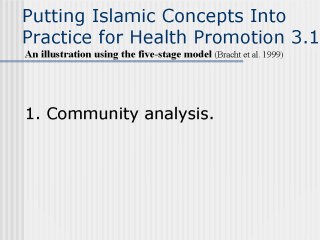 |
The first stage
requires a comprehensive accurate analysis and understanding of a community’s needs,
resources, social structure, and values. To encourage and ensure that programs designed
reflect these, this stage requires as well the involvement of community leaders. Islamic
concepts based on the Quran and Ahadith are the starting point in understanding the social
structure and values of an Islamic community. Imams and Quranic teachers are the main
sources through which Muslims learn the teachings of the Quran and Ahadith and so could be
construed as primary Islamic leaders in an Islamic community. The understanding of various
Islamic concepts such as the three major concepts of Islam (‘Five pillars of Islam’,
Elements of Imaan-Faith’ and Islamic Jurisprudence) can facilitate an in-depth community
analysis of an Islamic community. These three major concepts of Islam have given birth to
various other concepts, which are applied in various forms in different Islamic
communities worldwide. These concepts include Da’wah’, ‘Shariah’,’ Shuura’,
‘Hisba’ and ‘Waqf’ among many other concepts. Da’wah for instance means
invitation. Islam encourages everyone to invite each other to understand or to know what
is good and to forbid what is bad. This is clearly stated in the Quran (9:71) as “The
Believers, men and women, are protectors, one of another: they enjoin what is just, and
forbid what is evil: they observe regular prayers, practice regular charity, and obey
Allah and His Messenger. On them will Allah pour His Mercy: Allah is Exalted in power,
Wise.” This however does not mean coercion in fact the Quran (16:125) states “Invite
(all) to the way of thy lord with wisdom and beautiful Preaching; and argue with them in
ways that are best and most gracious: for thy lord knoweth best, who have strayed from his
path and who received guidance.” In understanding this simple but very important
Islamic concept health promoters can initiate dialogues with Muslims directly at
individual level or indirectly through their leaders. This dialogue in turn will offer the
possibility for a comprehensive analysis and understanding of an Islamic community to
conclude this first stage of Bracht et al. (1999) five-stage model. Reference:
Bracht, N., Kingsbury, L. & Rissel L. (1999). A Five stage Community
Organization Model for Health Promotion. In Bracht, N (Ed.). Health Promotion at the
community Level. (pp 83-104). International Educational and Professional Publisher,
Thousand Oaks, California 91320. SAGE Publications |
